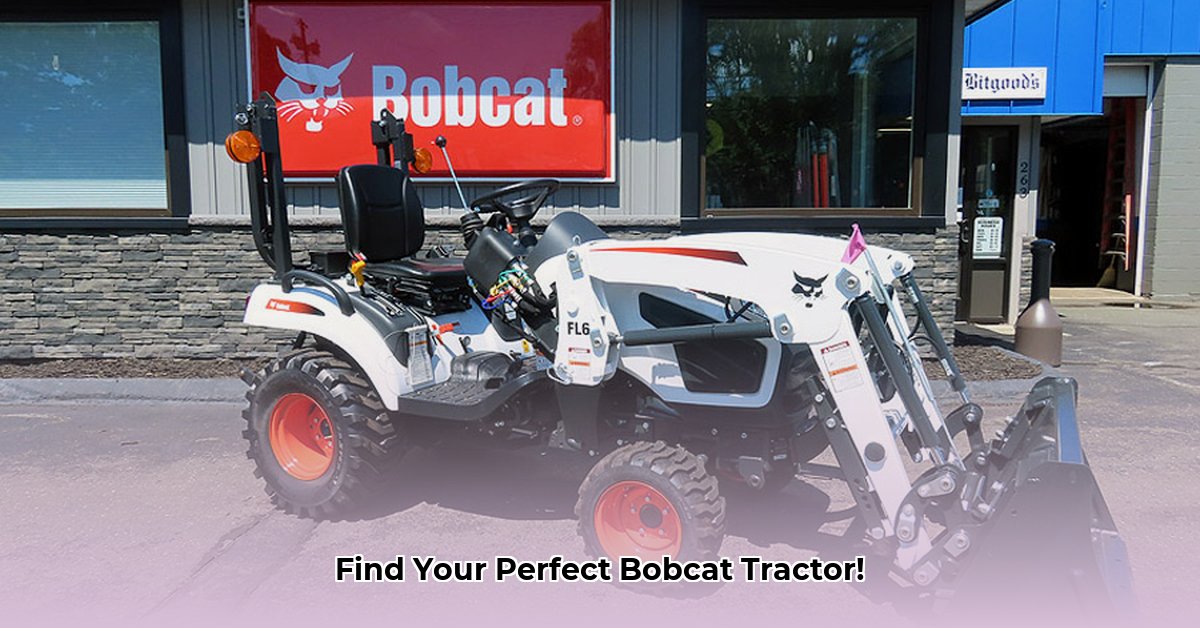
Thinking about adding a sub-compact tractor to your property? Bobcat offers a robust lineup within their 1000 series, making the decision process potentially overwhelming. This buyer's guide simplifies the selection process, focusing on key features to help you choose the perfect model for your needs. For more information on attachments, see this helpful guide on rototiller options.
Power and Performance: Choosing the Right Horsepower
Bobcat sub-compact tractors offer a range of horsepower options, directly impacting the tractor's pulling power. More horsepower translates to tackling tougher jobs, but comes with increased fuel consumption. Smaller engines, while less powerful, generally offer better fuel economy – a crucial factor for long-term cost-effectiveness. What tasks will you primarily perform? Light yard work requires less horsepower than serious land clearing. Always consult the official Bobcat website or your local dealer for precise horsepower figures for each model.
Lifting Capacity: Meeting Your Material Handling Needs
Lift capacity is a critical factor, determining how much weight the tractor's loader can lift. This is paramount when moving heavy materials, such as gravel, soil, or pallets. A higher lift capacity is essential for demanding tasks. If you primarily move lighter garden supplies, a lower lift capacity might suffice. Refer to the official Bobcat specifications for accurate lift capacity figures for each model. Accurate data is crucial for informed decisions.
Transmission Types: Hydrostatic vs. Manual
Bobcat sub-compact tractors typically feature either a hydrostatic or a manual transmission. Hydrostatic transmissions offer user-friendly, variable-speed control via levers or pedals, ideal for beginners and those prioritizing ease of use. Manual transmissions, while offering greater control and potentially better fuel efficiency at a consistent speed, require more operator skill and involve gear shifting. Your experience level and the intended tasks should guide your transmission choice.
Features and Attachments: Expanding Your Tractor's Capabilities
The versatility of Bobcat sub-compact tractors extends through their broad range of compatible attachments. These attachments, often connected via a three-point hitch system, significantly expand the tractor's capabilities. Imagine easily switching from a tiller to a mower, a loader to a backhoe. Attachments dramatically enhance a tractor’s usefulness, transforming it from a single-purpose machine into a highly versatile tool.
Budget Considerations: Finding the Right Price Point
Bobcat sub-compact tractor prices vary widely depending on the model, features, and location. While precise pricing isn't provided here (due to regional variations), remember this is a significant investment. Consider long-term costs: A slightly pricier model with greater capabilities might prove more economical in the long run by reducing rental costs or speeding up tasks.
Model Comparison: A Quick Overview (Data to be Verified)
The following table provides a general comparison of key features. Always verify specifications and pricing with the official Bobcat website or your local dealer, as specifications are subject to change.
| Model | Horsepower (Approximate) | Lift Capacity (lbs) (Approximate) | Transmission Type | Price Range (USD) (Approximate) |
|---|---|---|---|---|
| Bobcat 1000 | Low to Medium | Low to Medium | Hydrostatic or Manual | Lower end of range |
| Bobcat 1025 | Medium | Medium | Hydrostatic or Manual | Mid-range |
| Bobcat 1050 | Medium to High | Medium to High | Hydrostatic or Manual | Higher end of range |
Weighing the Pros and Cons: A Balanced Perspective
Before committing to a purchase, consider the advantages and disadvantages of owning a Bobcat sub-compact tractor.
Pros:
- Maneuverability: Compact size ideal for navigating tight spaces.
- Versatility: Wide array of attachments expands functionality.
- User-Friendliness: Relatively easy to operate, suitable for beginners.
- Durability: Bobcat's reputation for building robust and reliable equipment.
Cons:
- Lifting Limits: Lower lift capacity compared to larger tractors.
- Power Limitations: Not suitable for all heavy-duty applications.
- Task Suitability: Carefully assess whether it meets your specific needs.
Your Next Steps: From Research to Ownership
This guide provides a foundational understanding. To finalize your decision, visit your local Bobcat dealer. They can address your questions, arrange test drives, and help select the perfect tractor for your needs and budget.